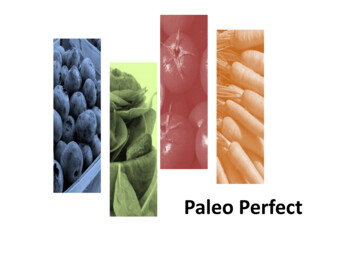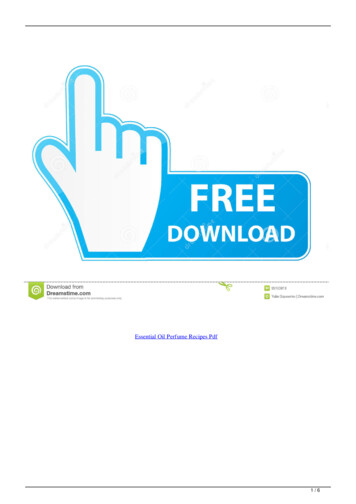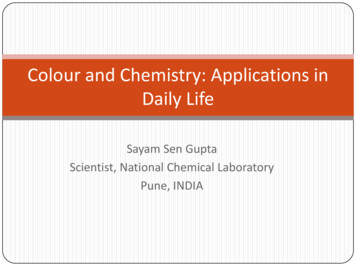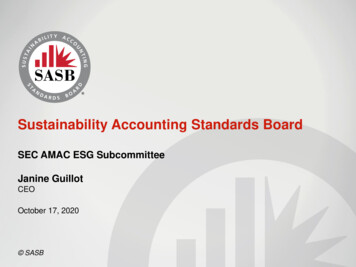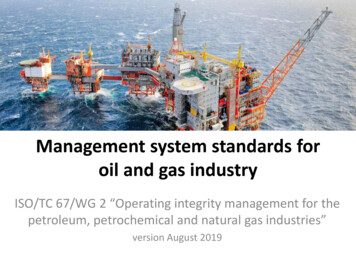
Transcription
Management system standards foroil and gas industryISO/TC 67/WG 2 “Operating integrity management for thepetroleum, petrochemical and natural gas industries”version August 2019
Outline Scope of ISO/TC 67/WG 2Background: ISO/TC 67 developmentsBackground: IOGP developmentsDevelopment of operating management system standard (ISO29010) Revision of quality management system standard (ISO 29001) Other standards in ISO/TC 67/WG 2 portfolio2
Scope of ISO/TC 67/WG 2 Provide requirements, guidance and tools to supportorganisations within the petroleum, petrochemical and naturalgas industries in establishing and implementing management,quality and conformity assessment processes to reduceoperating risk and drive improvement throughout their businessactivities3
Background: ISO/TC 67 developments (1)Industry eventsMontara (left) andMacondo (right) oilspill accidents, alsokilling people ISO/TC 67 adopted the following resolution in 2010:4
Background: ISO/TC 67 developments (2)Industry events Action plan industry events waspublished in March 2011,identifying 31 standards to beupdated or newly developed Related to MSS, action plan proposed to develop new ISOstandard based on inter alia OGP Report 210, IPIECA document,and API RP 75Press releaseby ISO5
Background: ISO/TC 67 developments (3)Quality management system standard Oil and gas industry published firstedition of sector-specific QMS standardfor product and service supplyorganizations, supplementing ISO 9001,in 2003 ISO/TS 29001 is used as example inplug-in model for ISO MSS:6
Background: ISO/TC 67 developments (4)Structure for management systems Discussion paper on structure for management systems inISO/TC 67 (through its management committee) Establishing AHG Management system standards structure in ISO/TC 67 per resolution 2013/21 (Oslo), ‘allocated’ to ISO/TC 67/WG 2 Basic ideas for structure of MSS in oil and gas industry:– Based on high level structure for MSS (Annex L)– Full standard rather than technical specification– Building on existing generic ISO standards and well acceptedknowledge sources in oil and gas industry– Originally based on concept of umbrella operating managementsystem standard interfacing with a series of existing disciplinespecific standards7
Background: ISO/TC 67 developments (5)Structure for management systems8
Background: IOGP developments (1)HSE management system guidelines IOGP published Report 210 in July 1994 Model for HSE management system:9
Background: IOGP developments (2)Operating management system framework IOGP & IPIECA published Reports 510 and 511in June 2014 Key drivers for revision of Report 210:– Company management systems havedeveloped considerably– Scope of systems has expanded– Lessons have been learned and many goodpractices have been shared across industry “Operating” applies to every type ofupstream or downstream company activity,from construction to decommissioning,throughout entire value chain and lifecycleof business and its products10
Background: IOGP developments (3)Operating management system framework OMS framework is designed to help companies define and achieveperformance goals and stakeholder benefits, while managing broadand significant range of risks inherent in oil and gas industry Key characteristics of an OMS:– Providing a holistic approach to risk in context of oil and gas assetoperational lifecycles– Framework detailing fundamentals, expectations and requirementsneeded to manage all operating activities– Organizations may use it to provide an ‘integrated approach’ toaddress all operational risks, or may use it in combination with‘stand-alone’ management systems with a specific risk focus– Framework is flexible to allow companies to adjust the systemscope to meet their risks and business approach11
Background: IOGP developments (4)Operating management system framework OMS framework model: 4 fundamentals underpin 10 elements12
Development of OMS standard (1)Justification Developing an OMS standard was identified as one of the priorityitems in action plan industry events IOGP & IPIECA welcomed initiative of ISO/TC 67 to develop OMSstandard based on their Reports 510 and 511 and provided letter ofsupport as part of justification study (JS) [required by ISO] IRF (International Regulators Forum) welcomed action plan industryevents OMS helpful tool to demonstrate compliance with safetyof (offshore) oil and gas operations WEF (World Economic Forum) supported initiative and referred toIOGP with which they already cooperate in view of standardisation(e.g. JIP 33 on standardisation of equipment and packages) TF leader for updating Handbook on integrated use of MSSssupported initiative and confirmed no duplication of work13
Development of OMS standard (2)Approach Use IOGP/IPIECA Report 510 as starting document as thisdocument:– Recognises an OMS covers all operating activities providing aframework to help and guide organisations define and achieveperformance goals and stakeholder benefits, whilst managinginherent risks– Offers single point flexibility to drive continual improvement, focusand react to a wide range of risks and threats, and to integratefunctional management standard requirements and deliverables– Addresses the hierarchy of a top system (i.e. OMS) and the subsystems, in which the expectations within the OMS frameworkresult in establishment of a range of more specific sub-systems,processes and practices to meet particular needs14
Development of OMS standard (3)Approach (continued) Configure IOGP/IPIECA Report 510 in line with HLS (Annex L) todevelop OMS standard that:– Provides a framework consistently delivering business resultsthrough discipline related management system requirements andensure consistency of common processes– Incorporates specific operating requirements and standardisationguidance– Incorporates latest best practices/lessons learnt and well acceptedknowledge sources in oil and gas industry– Interfaces with existing ISO standards and provides the detail onhow to implement them to manage risks in oil and gas industryNOTE: Operating management system should not be confused with anintegrated management system15
Development of OMS standard (4)Status Support for developing umbrella (OMS) standard for oil and gasoperators per resolution 2015/26 (Delft) First JS not approved by ISO/TMB, request for clarification Updated JS endorsed by ISO/TC 67 and approved by ISO/TMB16
Development of OMS standard (5)Status (continued) DIS version under developmentOMS modelunderdevelopment17
Development of OMS standard (6)Status (continued) Engaging and seeking involvement of more stakeholders byactive participation or sharing best practices / company modelsincluding organisation of OMS experiences sharing sessions Finalising DIS version containing requirements and guidancesupporting these requirements Developing additional guidance, intended to be published onpublic website of ISO/TC 67 DIS version intended to beavailable by end 2019 OMS standard intended tobe published in 2021OMS standard developmentstrategy paper18
Revision of ISO/TS 29001 (1)Justification Objectives for revision of ISO/TS 29001:2010 are to:– Align with ISO 9001:2015– Incorporate sector best practices– Incorporate sector risk management processes– Standardise the sector approach to implement quality andverification requirements– Provide clarity on sector documented information requirements– Reflect the requirements and guidance within sectorcomplementary quality, technical and conformity assessmentstandards/specifications19
Revision of ISO/TS 29001 (2)Approach ISO/TS 29001 will become full ISO standard building on ISO9001:2015 with sector-specific supplements, adding value by:– Implementing sector best practices– Ensuring processes systematically identify and manageorganisational and specific product and service risks– Incorporating an industry related conformity assessment annex– Providing options (data sheet) to avoid over complication– Aligning output with IOGP “JIP 33” standardisation project– Being equivalent to other industry specific QMS standards20
Revision of ISO/TS 29001 (3)Status Decision to initiate revision of ISO/TS 29001:2010 in view ofpublication of ISO 9001:2015 per resolution 2014/21 (Bangkok) JS endorsed by ISO/TC 67 and approved by ISO/TMB In addition to sector-specific supplements to ISO 9001:2015, newISO 29001 will contain informative annex on risk and opportunitymanagement and conformity assessment processes DIS ballot received 100 % approval and about 150 comments FDIS version submitted and ballot to be launched in Q4 of 2019 Publication of 4th edition of ISO 29001 expected early 2020 Separate documents with comparison matrices [ISO/TS 29001,API Q1 and API Q2], rationale of supplements, and guidance onuse of ISO 29001 to be published on public website of ISO/TC 6721
Revision of ISO/TS 29001 (4)Status (continued) Representation of new annex of risk and opportunitymanagement and conformity assessment processes22
Other ISO/TC 67/WG 2 standards (1) ISO 13879:1999, Content and drafting of a functional specification ISO 13880:1999, Content and drafting of a technical specification ISO/TR 13881:2000, Classification and conformity assessment ofproducts, processes and services23
Other ISO/TC 67/WG 2 standards (2) ISO/TS 17969:2017, Guidelines on competency management forwell operations personnelScope might be broadened tocover competency managementfor all kind of operations inoil and gas sector24
ContactsTed Fletcher (convenor) ted.fletcher@woodside.com.au 61 4 1919 9857Jarno Dakhorst (secretary) jarno.dakhorst@nen.nl 31 6 3333 4671Join our LinkedIn group"Operating integrity management for oil and gas 5
In addition to sector-specific supplements to ISO 9001:2015, new ISO 29001 will contain informative annex on risk and opportunity management and conformity assessment processes DIS ballot received 100 % approval and about 150 comments FDIS version submitted and ballot to be launched in Q4 of 2019 Publication of 4th edition of ISO .







